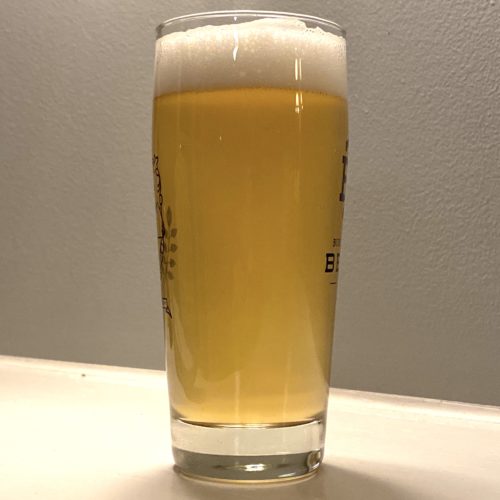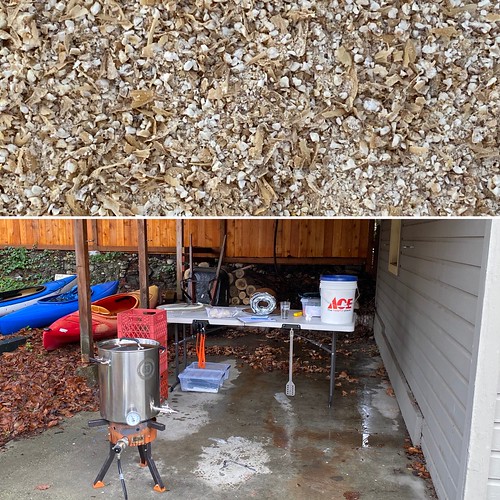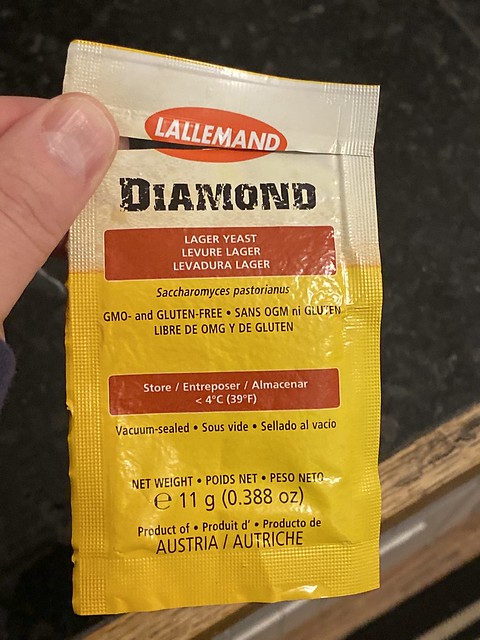Homebrew #95: Hoarder Intervention #3
¶ by Rob FrieselLong time readers of this blog will know from the name what’s in store here. When I call a beer “Hoarder Intervention”, it’s because it’s a “junk drawer” beer — as in: me cleaning out whatever junk is leftover. “What the hell can I do with this?” But whereas #1 and #2 required some supplementation from the local HBS, Hoarder Intervention #3 was brewed simply with what I had on-hand.

…which is to say that I spent $0 to brew this beer except gallons of water, propane, and my time.
I looked at the 5 lb. of Skagit Valley NZ-151 pale malt I had from my judge’s goodie bag from Ein Prosit and thought: “Not enough to brew a SMASH but…” 1 A 50/50 blend with my stock of Briess 2-row, then some of the Warrior and/or Chinook in the freezer, and then pick a dry strain from the crisper drawer.
It just might work…
Brew Day
It isn’t that I put zero effort into this beer, but I honestly don’t know that I’ve put less effort into any others. 2 I had some base malts and some “leftover” hops, and some yeast I could throw at it. All that’s left was water so… carbon filter and let BeerSmith tell you what you need for “Yellow Dry”.
Collect water, hit it with salts, crush grain… and we’re off!

(It’s worth mentioning that although technically this brew day was before I ran my brew house efficiency post, I’d run a bunch of those numbers already and was trying to put part of my theories to the test!) 3
I mashed in around 11:00am at 152ºF and just walked away for 90 minutes. (Hoarder Intervention style — don’t fuss with things, if you don’t have to.) 4 After that I pulled the bag, did my squeeze, and ran a little post-mash science. Approximately 1.049 wort gravity pre-boil, and about 6.2 gallons of volume.
Got the flame going, threw in 0.5 oz. of Warrior as FWH. Boiled for 30 minutes with 1 oz. of Chinook going in at flame-out. Chilled to approx. 70ºF. Post-boil science gave me 5.25 gallons in the fermentor at 1.056. (Brew house efficiency of 76.8% for those keeping score.)
Wort into the fermentor and into the fermentation chamber to finish chilling down to the 52±1ºF where I set the controller.

Still some open questions about my brew space ergonomics, and spending 15 minutes to chill 5 gallons that I only spent 30 minutes boiling seems… silly. But overall, a successful brew day.
Fermentation
As I was planning on making this an (unconventional) lager, I set my controller to 52±1ºF and let the chest freezer bring the wort temperature down the rest of the way. I’d looked through my stash of dry yeast packets in the my crisper drawer and ultimately settled on Diamond: 5

I’d never brewed with it before, but it seemed like a fairly straightforward less-than-fussy lager strain. And given the Hoarder Intervention philosophy… this seemed like the perfect opportunity to roll the dice on it.
I rehydrated (albeit not with GoFerm) and pitched a single sachet — as that was the only sachet I had. Then I gave it oh… 48 hours or so to prove to me that it could do the job.
And by the 48 hour mark, I had enough activity in the blow-off bucket to satisfy me that it was fermenting away.
And though I was blasé about the recipe design and brew day, I got pretty attentive on the fermentation side. Semi-frequent refractometer readings, watching it come down — trying to follow that modified Narziss method.

And when it got down to past â…” of the estimated attenuation, I ramped up the temperature (approx. +5ºF every 12 hours until we hit 68±1ºF) to encourage complete attenuation and finish metabolizing the acetaldehyde and diacetyl etc.
What I did not do was cold crash.
Even though I added gelatin in the keg.
And then did some crank-and-shake carbonation for the second time ever. 6
Then hey — I think I have beer to drink?
Overall Impressions
Even after letting it settle out… didn’t exactly clear up like I thought it might. 7 And anyway, it’s a bit of a … non-conformist beer anyway so… at least it’s drinkable?

AROMA. Low malt aromas that present as faintly grainy-sweet, and not significant. Moderate hop aromas presenting as dried flowers, orange rind; low grapefruit flesh and background notes of pine needles. No significant esters. No detectable diacetyl nor DMS. Hard-to-pin-down off-aroma; not quite plastic, not quite Play-Doh? Maybe just-at-threshold chlorophenols and/or acetaldehyde? (Despite my best efforts? Maybe past-its-prime stressed yeast?)
APPEARANCE. Color is darker than straw but paler than yellow. Tall head of white, dense foam with very good persistence. Hazy, but not NEIPA hazy. (I can see my fingers through the beer but they’re fuzzy.)
FLAVOR. Soft grainy-sweet malt throughout; moderately low overall intensity. Medium-low hop flavors follow aroma: citrus (orange over grapefruit) with a little pine; floral elements present retronasally. Medium-low bitterness. No significant yeast-derived flavors. Again (as with aroma) there is a hard-to-place character that doesn’t overtly smack of any particular off-flavor — and again I might suspect a mix of just-at-threshold chlorophenols and/or acetaldehyde, but it’s hard to be sure. Finishes with the balance slightly toward the malt, but then a resurgence of the hop character in the aftertaste.
MOUTHFEEL. Medium-light body. Medium-high carbonation; a bit prickly in the finish. No significant alcohol warmth. No creaminess. No noticeable astringency.
OVERALL IMPRESSION. Doing the tasting notes for this beer, I am reminded of the time Erin had us blind-taste a Natty Daddy and attempt to place it in a BJCP category. “Where do you even put this beer?” And the most generous thing I can think to say about it is: “Not nearly as bad for the level of effort I put into it.” (Which again… practically zero.)
Stylistic feedback is hard when you don’t have a style to begin with. As a 2A. International Pale Lager or 1B. American Lager – entirely too much flavor. Plus the haze. Malt and hop character take it right out of all the Czech and German styles. Plus the haze. Just about everything else is ales which … no significant esters. But could reasonably pass for an 18A. Blonde Ale. What’s left? 34B. Mixed-Style Beer? (Mix of what though?) 34C. Experimental Beer? (Last refuge of the brewer scoundrel?)
Technically… that hard-to-place off-character is bugging me, and is the main thing keeping it at “just OK” as opposed to “actually decent”. I think it’s easy to point the finger at yeast here … perhaps stressed before they were even pitched. It’s enough to be distracting. (Not that I won’t finish the keg.)
TL;DR: It doesn’t help that it doesn’t have a style space, nor does it help that the faults are just at-threshold — there’s enough of a gap here between the beer it is and a good beer that I couldn’t in good conscience score it higher than low 20s.
Maybe 24 out of 50? I don’t know. I suspect I’m being too generous to my own beer here.
And anyway it’s not worth commenting on changes for next time because … it’s a Hoarder Intervention. Realistically there is no next time. Though I might want to double-check on my dry yeast stash. 8
Whatever. It drinks like a so-so beer and that’s good enough for a zero-effort homebrew.
Recipe
The all-grain (BIAB) recipe for Hoarder Intervention #3 is as follows:
Water Chemistry
Starting with the Seattle municipal water profile (carbon filtered) as a base:
| Ca | Mg | Na | SO4²- | Cl- | HCO3- |
|---|---|---|---|---|---|
| 51 | 12 | 6 | 104 | 44 | 23 |
- 0.43 g/gal. Epson salt
- 0.39 g/gal. gypsum
- 0.27 g/gal. calcium chloride
- 0.04 g/gal. salt
Grist
- 5 lb. Skagit Valley NZ-151 pale malt
- 5 lb. Briess 2-row brewer’s malt
Hop Schedule
- 0.5 oz. Warrior (30 min.)
- 1 oz. Chinook (0 min.)
Yeast
Lallemand Diamond Lager
Brew Day
- Collect 27.72 qt. water and heat to 155.7ºF. Mash in; hold at 147.9ºF for 90 minutes. No mash out.
- Remove filter bag from water. Squeeze filter bag to extract as much liquid as possible for wort. No sparge. Pre-boil volume should be 6.2 gallons.
- Bring to a boil. Boil for 30 minutes; follow hop schedule as described above.
- Cool to 70ºF as rapidly as possible. Post-boil volume should be approx. 5 gallons. Place wort in fermentation chamber to cool the rest of the way to pitching temperatures, approx. 52ºF.
- Aerate wort; pitch rehydrated Diamond Lager yeast.
- Start fermentation at 52±1ºF.
Beyond Brew Day
- Follow a modified Narziss lager fermentation schedule. Ferment at 52±1ºF until approx. â…“ of expected gravity remains until F.G.
- With â…“ of gravity remaining until F.G., raise the controller temperature +5ºF every 12 hours until reaching 68ºF.
- Hold the temperature at 68ºF until F.G. is reached, then hold there for an additional 2-3 days.
- Separate the beer from the yeast (i.e., rack to a keg). Optionally fine with gelatin. Move to cold storage for lagering.
- Carbonate to approx. 2.5 volumes.
- Enjoy!
Details
Hoarder Intervention #3, a junk-drawer lager by Tilde Gravitywerks
| Original Gravity | 1.056 |
| Final Gravity | 1.011 |
| ABV | 6.0% |
| Attenuation | 79.6% |
| IBU | 22 |
| SRM | 4 |
| Links | Flickr |
- Well… not enough for a 5 gallon SMASH. Probably could have managed at 3 gallons it could have been a fun little session beer.[↩]
- You could argue that I put less effort into my early kit beers because those just come and … then you brew them. But I would argue that (1) I way over-thought the selection on every single kit I ever bought with the possible exception of that very first one, and (2) even though they were extract beers I also way over-thought every step of the entire brewing process. So I’ll stand by my original statement: this beer got the least effort of any beer to-date.[↩]
- Spoiler alert: my brew house efficiency theory held up reasonably well on this brew day.[↩]
- In other words: I did other house chores.[↩]
- W34/70 was the other contender.[↩]
- Slightly less… disastrous (??) than the first time. All things considered, folks: burst carbonation is safer for everyone and takes about the same amount of time so… let my failures be a lesson to you.[↩]
- In fairness, I only “lagered” it about a week or two before I tucked into it. For all I know, it’ll be nice and bright in another week or so.[↩]
- And/but/so maybe steer clear of that Diamond Lager yeast?[↩]
Leave a Reply